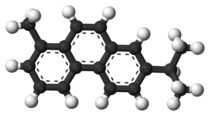| Revision as of 16:01, 19 April 2011 editCheMoBot (talk | contribs)Bots141,565 edits Updating {{chembox}} (no changed fields - added verified revid - updated 'UNII_Ref', 'ChemSpiderID_Ref', 'StdInChI_Ref', 'StdInChIKey_Ref', 'ChEMBL_Ref', 'KEGG_Ref') per Chem/Drugbox validation (← Previous edit | Revision as of 15:00, 5 May 2011 edit undo130.15.91.167 (talk) -added reference for presence of retene in pulp and paper mill effluent.Next edit → | ||
| Line 34: | Line 34: | ||
| Retene is derived by degradation of specific ]s biologically produced by ] trees. | Retene is derived by degradation of specific ]s biologically produced by ] trees. | ||
| The presence of traces of retene in the air is an indicator of ]s; it is a major product of ] of ] trees.<ref>, Community Outreach and Education Program, Oregon State University</ref> It is also present in ]s from ] and ]s.{{ |
The presence of traces of retene in the air is an indicator of ]s; it is a major product of ] of ] trees.<ref>, Community Outreach and Education Program, Oregon State University</ref> It is also present in ]s from ] and ]s.<ref>{{cite journal|journal=Chemosphere|volume=37|pages=219-235|year=1998|title=IDENTIFICATION OF LIPOPHILIC POLLUTANTS DISCHARGED FROM A FINNISH PULP AND PAPER MILL|author=J. Koistinen, M. Lehtonena, K. Tukia, M. Soimasuo, M. Lahtiperab and A. Oikari|url=http://www.sciencedirect.com/science?_ob=ArticleURL&_udi=B6V74-3T7D8PM-J&_user=1025668&_coverDate=07%2F31%2F1998&_rdoc=1&_fmt=high&_orig=gateway&_origin=gateway&_sort=d&_docanchor=&view=c&_searchStrId=1741864963&_rerunOrigin=scholar.google&_acct=C000050549&_version=1&_urlVersion=0&_userid=1025668&md5=abece145534dfbeaafdd11a6542ffb04&searchtype=a}}</ref> | ||
| Retene, together with ], ] and ], is a ] of ]s, which makes it useful for ] analysis of rock ]s. Ratio of retene/cadalene in sediments can reveal the ratio of the genus '']'' in the biosphere.<ref>{{cite journal|journal=Geophysical Research Abstracts|volume=7|pages=10201|year=2005|title=Vascular plant biomarkers as ancient vegetation proxies and their stratigraphic use for tracing paleoclimatic changes during Jurassic in Western Europe|author=Y. Hautevelle, R. Michels, F. Malartre and A. Trouiller|url=http://www.cosis.net/abstracts/EGU05/10201/EGU05-J-10201.pdf|format=abstract}}</ref> | Retene, together with ], ] and ], is a ] of ]s, which makes it useful for ] analysis of rock ]s. Ratio of retene/cadalene in sediments can reveal the ratio of the genus '']'' in the biosphere.<ref>{{cite journal|journal=Geophysical Research Abstracts|volume=7|pages=10201|year=2005|title=Vascular plant biomarkers as ancient vegetation proxies and their stratigraphic use for tracing paleoclimatic changes during Jurassic in Western Europe|author=Y. Hautevelle, R. Michels, F. Malartre and A. Trouiller|url=http://www.cosis.net/abstracts/EGU05/10201/EGU05-J-10201.pdf|format=abstract}}</ref> | ||
Revision as of 15:00, 5 May 2011

| |

| |
| Names | |
|---|---|
| IUPAC name 7-Isopropyl-1-methylphenanthrene | |
| Other names Retene | |
| Identifiers | |
| CAS Number | |
| 3D model (JSmol) | |
| ECHA InfoCard | 100.006.908 |
| PubChem CID | |
| CompTox Dashboard (EPA) | |
SMILES
| |
| Properties | |
| Chemical formula | C18H18 |
| Molar mass | 234.33552 |
| Melting point | 98.5 °C |
| Boiling point | 390 °C |
| Except where otherwise noted, data are given for materials in their standard state (at 25 °C , 100 kPa).
| |
Retene, methyl isopropyl phenanthrene or 1-methyl-7-isopropyl phenanthrene, C18H18, is a polycyclic aromatic hydrocarbon present in the coal tar fraction, boiling above 360 °C. It occurs naturally in the tars obtained by the distillation of resinous woods. It crystallizes in large plates, which melt at 98.5 °C and boil at 390 °C. It is readily soluble in warm ether and in hot glacial acetic acid. Sodium and boiling amyl alcohol reduce it to a tetrahydroretene, whilst if it be heated with phosphorus and hydriodic acid to 260 °C, a dodecahydride is formed. Chromic acid oxidizes it to retene quinone, phthalic acid and acetic acid. It forms a picrate which melts at 123-124 °C.
Retene is derived by degradation of specific diterpenoids biologically produced by conifer trees.
The presence of traces of retene in the air is an indicator of forest fires; it is a major product of pyrolysis of conifer trees. It is also present in effluents from wood pulp and paper mills.
Retene, together with cadalene, simonellite and ip-iHMN, is a biomarker of higher plants, which makes it useful for paleobotanic analysis of rock sediments. Ratio of retene/cadalene in sediments can reveal the ratio of the genus Pinaceae in the biosphere.
References
- Unsolved Mysteries of Human Health, Community Outreach and Education Program, Oregon State University
- J. Koistinen, M. Lehtonena, K. Tukia, M. Soimasuo, M. Lahtiperab and A. Oikari (1998). "IDENTIFICATION OF LIPOPHILIC POLLUTANTS DISCHARGED FROM A FINNISH PULP AND PAPER MILL". Chemosphere. 37: 219–235.
{{cite journal}}: CS1 maint: multiple names: authors list (link) - Y. Hautevelle, R. Michels, F. Malartre and A. Trouiller (2005). "Vascular plant biomarkers as ancient vegetation proxies and their stratigraphic use for tracing paleoclimatic changes during Jurassic in Western Europe" (abstract). Geophysical Research Abstracts. 7: 10201.
{{cite journal}}: CS1 maint: multiple names: authors list (link)
![]() This article incorporates text from a publication now in the public domain: Chisholm, Hugh, ed. (1911). Encyclopædia Britannica (11th ed.). Cambridge University Press.
This article incorporates text from a publication now in the public domain: Chisholm, Hugh, ed. (1911). Encyclopædia Britannica (11th ed.). Cambridge University Press. {{cite encyclopedia}}: Missing or empty |title= (help)